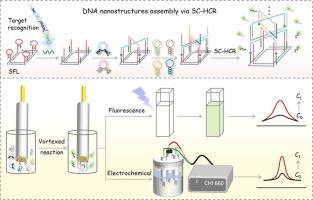利用超交叉杂交链反应组装DNA纳米结构用于超灵敏双模生物传感
IF 3.7
1区 化学
Q1 CHEMISTRY, ANALYTICAL
引用次数: 0
摘要
杂交链反应为构建用于电化学生物传感的DNA纳米结构提供了一种有效的方法。然而,它们大多依赖于各种线性DNA组装反应。在此,我们设计了一种新的超交叉杂交链反应(SC-HCR),用于高效组装稳定的DNA纳米结构,从而开发了一种用于卡那霉素(Kana)抗生素检测的电化学/荧光双模式生物传感方法。在外切酶iii辅助信号扩增到SC-HCR的情况下,我们证明了在0.1 pg mL-1 ~ 10 ng mL-1的线性范围内对伪名进行超灵敏的电化学检测,检测限低至15.1 fg mL-1。同时,提出了一种“废转信号”策略,在1 pg mL-1 ~ 100 ng mL-1的线性范围内实现了假ana的超灵敏荧光检测,检出限为0.194 pg mL-1。由于整个测定过程均在均匀溶液中进行,该方法操作简单,重复性好。此外,检测结果的双模交叉验证决定了该方法具有良好的准确性和可靠性,具有较好的实际应用价值。这种SC-HCR也为稳定的DNA纳米结构的高效组装提供了一种新的方法。本文章由计算机程序翻译,如有差异,请以英文原文为准。

DNA nanostructure assembly via super-intercrossed hybridization chain reaction for ultrasensitive dual-mode biosensing
Hybridization chain reaction provides a useful approach to construct DNA nanostructures for electrochemical biosensing. However, most of them rely on various linear DNA assembly reactions. Herein, we design a novel super-intercrossed hybridization chain reaction (SC-HCR) for efficient assembly of a stable DNA nanostructure, thus developing an electrochemical/fluorescence dual-mode biosensing method for kanamycin (Kana) antibiotic detection. Under the exonuclease III-assisted signal amplification to SC-HCR, we demonstrated the ultrasensitive electrochemical detection of Kana in the linear range from 0.1 pg mL–1 to 10 ng mL–1 with a detection limit down to 15.1 fg mL–1. Meanwhile, a "waste-to-signal" strategy was proposed to achieve the ultrasensitive fluorescence detection of Kana in the linear range from 1 pg mL–1 to 100 ng mL–1 with a detection limit of 0.194 pg mL–1. As the whole assay was performed in homogeneous solutions, this method has simple operability and good repeatability. In addition, the dual-mode cross-validation to detection results decides the excellent accuracy and reliability of the method and its good value for practical application. This SC-HCR also provides a novel approach for efficient assembly of stable DNA nanostructures.
求助全文
通过发布文献求助,成功后即可免费获取论文全文。
去求助
来源期刊

Sensors and Actuators B: Chemical
工程技术-电化学
CiteScore
14.60
自引率
11.90%
发文量
1776
审稿时长
3.2 months
期刊介绍:
Sensors & Actuators, B: Chemical is an international journal focused on the research and development of chemical transducers. It covers chemical sensors and biosensors, chemical actuators, and analytical microsystems. The journal is interdisciplinary, aiming to publish original works showcasing substantial advancements beyond the current state of the art in these fields, with practical applicability to solving meaningful analytical problems. Review articles are accepted by invitation from an Editor of the journal.
 求助内容:
求助内容: 应助结果提醒方式:
应助结果提醒方式:


